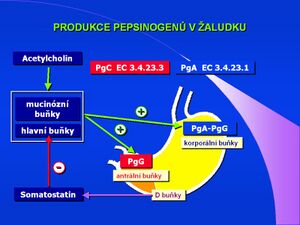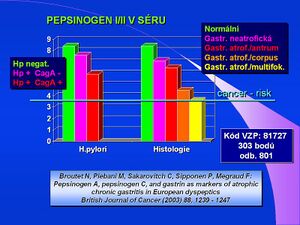Pepsin
(přesměrováno z Pepsin - pepsinogeny)
Pepsin[upravit | editovat zdroj]
Pepsin je obecné označení pro řadu proteináz (pepsin A,B,C – EC 3.4.23.1,2,3), pepsinogeny jsou jejich prekurzory (proenzymy). Aktivace pepsinogenu A na pepsin A probíhá v kyselém prostředí, vznikající pepsin A je schopen další aktivace pepsinogenu a vede k tzv. autokatalýze. Elektroforeticky lze separovat v agarovém gelu 8 proteáz žaludeční sliznice, pepsinogeny PG1–PG5 tvoří skupinu imunologicky identických proteinů – pepsinogen I (PG-I, PGA), pepsinogeny PG6 a PG7 tvoří skupinu pepsinogenu II (PG-II, PGC), posledním proteinem je katepsin E (SMP, slow moving proteinase). Molekulová hmotnost pepsinogenu I je 42 500.
Pepsin se řadí mezi endopeptidázy, hydrolyzuje tedy peptidové vazby uvnitř molekuly, čímž ji štěpí na menší fragmenty. V žaludeční šťávě hydrolyzuje vazby v blízkosti aminokyselin, které mají velké postranní řetězce (AMK s aromatickými zbytky, rozvětvenými řetězci a methionin).[1]
Klinický význam[upravit | editovat zdroj]
Klinický význam má stanovení pepsinu při insulinovém testu a sérová hladina pepsinogenů A a C. Ke stanovení se používá RIA metodika s 125I-pepsinogenem v kompetitivním uspořádání. Pepsinogen A je markerem slizniční atrofie a je používán v genetických studiích jako subklinický marker vředové choroby duodena. Pepsinogen C je používán jako marker stavu žaludeční sliznice (případně v poměru PG-A/PG-C) a rovněž jako marker eradikace infekce Helicobacter pylori. Snížení hladiny pepsinogenu A prokazujeme u nemocných s achlorhydrií, např. u perniciózní anémie. Nejnovější studie prokazují významné snížení pepsinogenu-I a současně zvýšení hladiny IgA protilátek k Helicobacter pylori u karcinomu žaludku.
Stanovení poměru hladin obou pepsinogenů (PG-I:PG-II) je dnes považováno za nejvýhodnější variantu serologických markerů. Poměr PG-I:PG-II signifikantně klesá v závislosti na histologickém riziku, nebo přítomnosti vacA+ pozitivity Helicobacter pylori infekce. Kombinace stanovení hladiny pepsinogenu-I, gastrinu-17 a protilátek k Helicobacter pylori je testováno jako tzv. serologická biopsie, GastroPanel, v diferenciální diagnostice gastritid. Screeningové testování rizika atrofické gastritídy, resp. rizika karcinomu žaludku, ve spojení s pozitivitou Helicobacter pylori, je další oblastí screeningu nádorů gastrointestinálního traktu.
Odkazy[upravit | editovat zdroj]
Použitá literatura[upravit | editovat zdroj]
- DI MARIO, F, et al. Non-invasive tests in gastric diseases. Dig Liver Dis. 2008, vol. 40, no. 7, s. 523-30, ISSN 1590-8658 (Print), 1878-3562 (Electronic). PMID: 18439884.
- CHUNG, HW, et al. Comparison of the validity of three biomarkers for gastric cancer screening: carcinoembryonic antigen, pepsinogens, and high sensitive C-reactive protein. J Clin Gastroenterol. 2009, vol. 41, no. 3, s. 19-26, ISSN 0192-0790 (Print), 1539-2031 (Electronic). PMID: 18648315.
- YANAOKA, K, et al. Risk of gastric cancer in asymptomatic, middle-aged Japanese subjects based on serum pepsinogen and Helicobacter pylori antibody levels. Int J Cancer. 2008, vol. 123, no. 4, s. 917-26, ISSN 0020-7136 (Print), 1097-0215 (Electronic). PMID: 18508314.
- XIE, XF, et al. Serum pepsinogen levels in the Japanese population: prospective study of 9 years of follow-up. Hepatogastroenterology. 2007, vol. 54, no. 78, s. 1887-90, ISSN 0172-6390 (Print). PMID: 18019741.
- MIKI, K, et al. Using serum pepsinogens wisely in a clinical practice. J Dig Dis. 2007, vol. 8, no. 1, s. 8-14, ISSN 1751-2972 (Print), 1751-2980 (Electronic). PMID: 17261129.
- CAO, Q, et al. Screening of atrophic gastritis and gastric cancer by serum pepsinogen, gastrin-17 and Helicobacter pylori immunoglobulin G antibodies. J Dig Dis. 2007, vol. 8, no. 1, s. 15-22, ISSN 1751-2972 (Print), 1751-2980 (Electronic). PMID: 17261130.
- LOPES, AI, et al. Relationship among serum pepsinogens, serum gastrin, gastric mucosal histology and H. pylori virulence factors in a paediatric population. Scand J Gastroenterol. 2006, vol. 41, no. 5, s. 524-31, ISSN 0036-5521 (Print), 1502-7708 (Electronic). PMID: 16638693.
- STEMMERMANN, GN, et al. The relation of pepsinogen group II (PGII) expression to intestinal metaplasia and gastric cancer. Histopathology. 2006, vol. 49, no. 1, s. 45-51, ISSN 0309-0167 (Print), 1365-2559 (Electronic). PMID: 16842245.
- DERAKHSHAN, MH, et al. Gastric histology, serological markers and age as predictors of gastric acid secretion in patients infected with Helicobacter pylori. J Clin Pathol. 2006, vol. 59, no. 12, s. 1293-9, ISSN 0021-9746 (Print), 1472-4146 (Electronic). PMID: 16644877.
- NARDONE, G, et al. Diagnostic accuracy of the serum profile of gastric mucosa in relation to histological and morphometric diagnosis of atrophy. Aliment Pharmacol Ther. 2005, vol. 22, no. 11-12, s. 1139-46, ISSN 0269-2813 (Print), 1365-2036 (Electronic). PMID: 16305728.
- HOKKANEN, S, et al. Normal serum pepsinogen I levels in adults: a population-based study with special reference to Helicobacter pylori infection and parietal cell antibodies. Scand J Clin Lab Invest. 2005, vol. 65, no. 4, s. 291-9, ISSN 0036-5513 (Print), 1502-7686 (Electronic). PMID: 16076684.
- GERMANÁ, B, et al. Clinical usefulness of serum pepsinogens I and II, gastrin-17 and anti-Helicobacterpylori antibodies in the management of dyspeptic patients in primary care. Dig Liver Dis. 2005, vol. 37, no. 7, s. 501-8, ISSN 1590-8658 (Print), 1878-3562 (Electronic). PMID: 15975537.
- OHKUSA, T, et al. Improvement in serum pepsinogens and gastrin in long-term monitoring after eradication of Helicobacter pylori: comparison with H. pylori-negative patients. Aliment Pharmacol Ther. 2004, vol. 20, Suppl 1, s. 25-32, ISSN 0269-2813 (Print), 1365-2036 (Electronic). PMID: 15298602.
- URITA, Y, et al. Serum pepsinogens as a predicator of the topography of intestinal metaplasia in patients with atrophic gastritis. Dig Dis Sci. 2004, vol. 49, no. 5, s. 795-801, ISSN 0163-2116 (Print), 1573-2568 (Electronic). PMID: 15259501.
- OHATA, H, et al. Progression of chronic atrophic gastritis associated with Helicobacter pylori infection increases risk of gastric cancer. Int J Cancer. 2004, vol. 109, no. 1, s. 138-43, ISSN 0020-7136 (Print), 1097-0215 (Electronic). PMID: 14735480.
- KONTUREK, SJ, et al. Serum progastrin and its products, gastric acid secretion and serum pepsinogen I in gastric cancer. Digestion. 2003, vol. 68, no. 4, s. 169-77, ISSN 0012-2823 (Print), 1421-9867 (Electronic). PMID: 14671424.
- VÄÄNÄNEN, H, et al. Non-endoscopic diagnosis of atrophic gastritis with a blood test. Correlation between gastric histology and serum levels of gastrin-17 and pepsinogen I: a multicentre study. Eur J Gastroenterol Hepatol. 2003, vol. 15, no. 8, s. 885-91, ISSN 0954-691X (Print), 1473-5687 (Electronic). PMID: 12867799.
- MIKI, K, et al. Usefulness of gastric cancer screening using the serum pepsinogen test method. Am J Gastroenterol. 2003, vol. 98, no. 4, s. 735-9, ISSN 0002-9270 (Print), 1572-0241 (Electronic). PMID: 12738449.
- SANDULEANU, S, et al. Ratio between serum IL-8 and pepsinogen A/C: a marker for atrophic body gastritis. Eur J Clin Invest. 2003, vol. 33, no. 2, s. 147-54, ISSN 0014-2972 (Print), 1365-2362 (Electronic). PMID: 12588289.
- BROUTET, N, et al. Pepsinogen A, pepsinogen C, and gastrin as markers of atrophic chronic gastritis in European dyspeptics. Br J Cancer. 2003, vol. 88, no. 8, s. 1239-47, ISSN 0007-0920 (Print), 1532-1827 (Electronic). PMID: 12698190.
- SIPPONEN, P, et al. Serum levels of amidated gastrin-17 and pepsinogen I in atrophic gastritis: an observational case-control study.. Scand J Gastroenterol. 2002, vol. 37, no. 7, s. 785-91, ISSN 0036-5521 (Print), 1502-7708 (Electronic). PMID: 12190091.
- MÅRDH, E, et al. Diagnosis of gastritis by means of a combination of serological analyses. Clin Chim Acta. 2002, vol. 320, no. 1-2, s. 17-27, ISSN 0009-8981 (Print), 1873-3492 (Electronic). PMID: 11983196.
- LORENTE, S, et al. Helicobacter pylori stimulates pepsinogen secretion from isolated human peptic cells. Gut. 2002, vol. 50, no. 1, s. 13-8, ISSN 0017-5749 (Print), 1468-3288 (Electronic). PMID: 11772960.
- TABATA, H, et al. Difference in degree of mucosal atrophy between elevated and depressed types of gastric epithelial tumors. Scand J Gastroenterol. 2001, vol. 36, no. 11, s. 1134-40, ISSN 0036-5521 (Print), 1502-7708 (Electronic). PMID: 11686211.
- BODGER, K, et al. Variation in serum pepsinogens with severity and topography of Helicobacter pylori-associated chronic gastritis in dyspeptic patients referred for endoscopy. Helicobacter. 2001, vol. 6, no. 3, s. 216-24, ISSN 1083-4389 (Print), 1523-5378 (Electronic). PMID: 11683924.
- BERMEJO, F, et al. Basal concentrations of gastrin and pepsinogen I and II in gastric ulcer: influence of Helicobacter pylori infection and usefulness in the control of the eradication.. Gastroenterol Hepatol. 2001, vol. 24, no. 2, s. 56-62, ISSN 0210-5705. PMID: 11247290.
Zdroj[upravit | editovat zdroj]
- Se svolením autora převzato z KOCNA, Petr. GastroLab : MiniEncyklopedie laboratorních metod v gastroenterologii [online]. ©2002. Poslední revize 2011-01-08, [cit. 2011-03-04]. <http://www1.lf1.cuni.cz/~kocna/glab/glency1.htm>.
- ↑ Harper's illustrated biochemistry. Thirtieth edition. New York: McGraw Hill-Education, [2015], s. 539. Lange medical book. ISBN 978-1-25-925286-0.



